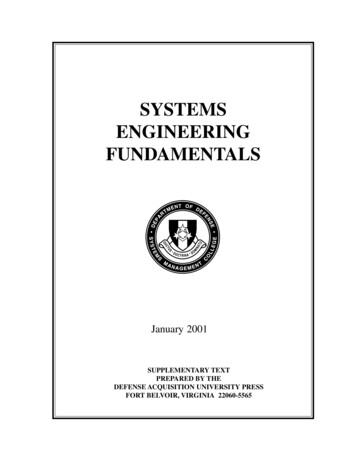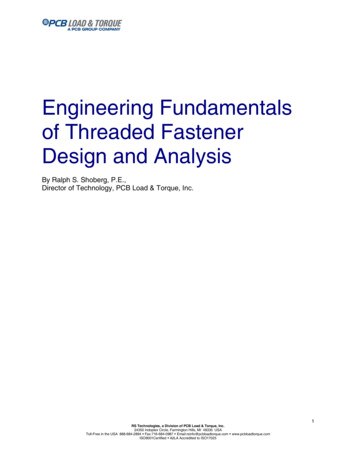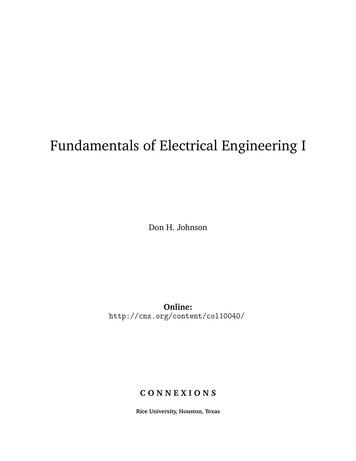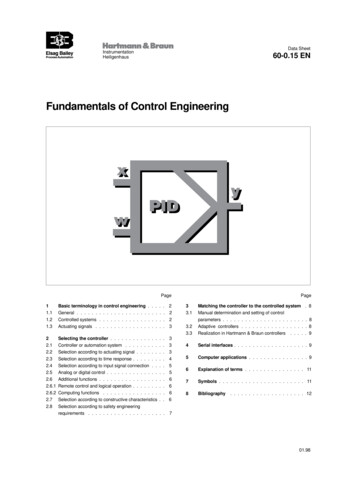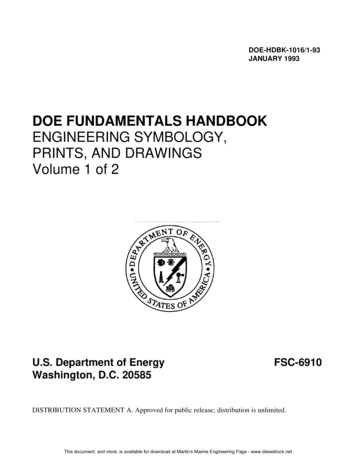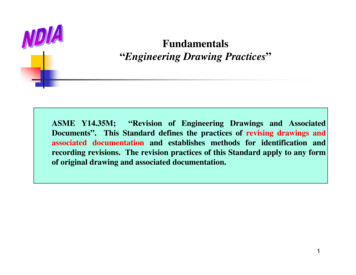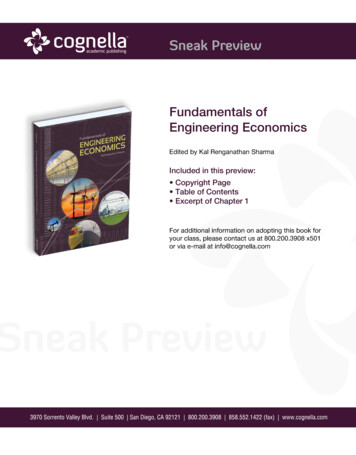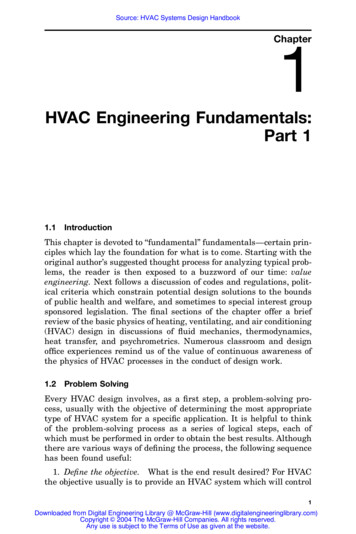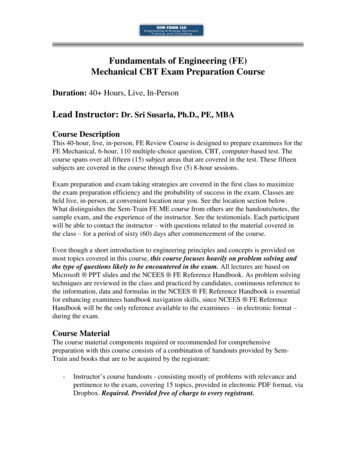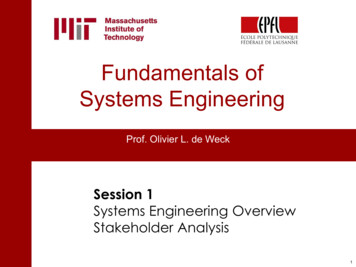
Transcription
Fundamentals ofSystems EngineeringProf. Olivier L. de WeckSession 1Systems Engineering OverviewStakeholder Analysis1
Class Parameters This class is an introduction to the Fundamentals of SystemsEngineering, a “door opener” to this important and evolving field Ideal for graduate students (1st, 2nd year of masters program) Some advanced undergraduates or returning professionals can also benefit Taught in format of a SPOC (Small Private Online Course) All lectures are recorded and available online on webex At MIT: 16.842, 6 units, taught in 9-057 and webex format Serves as a core class in the Department of Aeronautics and Astronautics forstudents interested in the ‘systems tracks’ and doctoral qualifying exams At EPFL: ENG-421, 5 ECTS credits, taught in ODY-10020 and webex Serves as one of the core classes in the new Minor in Systems Engineering2
Agenda for Today Introductions Personal Introductions Course Introduction, incl. Learning Objectives Systems Engineering (SE) Overview A bit of history The “V”-Model SE Standards and Handbooks Challenges of current practice Stakeholder AnalysisShort Break Identifying Stakeholders CONOPS Stakeholder Value Network (SVN) Analysis Assignment A1 2016 Cansat Competition, Team Formation etc 3
Personal Intro Olivier de Weck Dipl. Ing. Industrial Engineering – ETH Zurich 1992 1993-1997 Engineering Program Manager Swiss F/A-18Project, RUAG (formerly F W Emmen) Liaison Engineer at McDonnell Douglas, St. Louis S.M.’99 Ph.D.’01 Aerospace Systems – MIT Visiting Researcher at NASA Goddard Spaceflight Center Professor – dual appointment Department of Aeronauticsand Astronautics and Institute for Data, Systems, andSociety (IDSS) Adjunct Professor at EPFL, since 2012 Editor-in-Chief Journal Systems Engineering (since 2013) MIT Strategic Engineering Research Group: http://strategic.mit.edu4
A Transatlantic Journey 1997MIT CambridgeBoeingSt. LouisJPLPasadenaNASA Goddard SFC1993NASA JSCHoustonETH ZurichNASA KSCFlorida19872012What’s wrong with this picture?RUAG AerospaceFribourgEPFLLausanneZuozZermatt5
F/A-18 Complex System ChangeF/A-18 System Level DrawingManufacturingprocesses changedOriginal changeFuselageStiffenedFlight controlsoftware changedGross takeoffweight increasedCenter of gravity shiftedImage by MIT OpenCourseWare.6
F/A-18 Center Barrel SectionY453Y470.5Y488WingAttachment74A324001 2015 Olivier de Weck,Page 77
Lessons Learned from Swiss F/A-18 Program High-performance aircraft are very complex internally propulsion, avionics, structures Changing requirements can have ripple effectsbecause everything is tightly coupled It is difficult to predict the totality of system interactionsahead of time The “whole” system is much more than the airvehicle: logistics, training, incl. simulators etc. People matter a lot: contracts, culture, incentives .8
And who are you ? Briefly introduce yourself Name Department or Lab Affiliation Any prior experience with Systems Engineering ? Name one thing you want to learn in this class Try to keep it to 30 seconds or less9
Motivation for this class Aerospace Systems deliver important functions to society airtransportation, defense, sensing, exploration Complex “machines” with thousands of unique parts andpotentially millions of interactions Many aerospace systems require 6 levels of decomposition to arrive at indivisibleparts that cannot be taken “a-part” Humans play an important role as designers, operators,beneficiaries, maintainers . Best Practices have emerged since the 1960’s and arecontinuously evolving documented in standards/handbooks Limitations of “traditional” SE System safety recent SpaceX Falcon 9 launch failure Typical program cost and schedule overruns . Boeing Dreamliner 787 delays Systems Engineering is also penetrating in other industries Automobiles, Software, Medical Devices .10
Example: FLIR System for AircraftFLIR Forward Looking InfraredThe FLIR System AN/AAQ-22 Star SAFIRE electro-optical/infraredsensor has been designed to provide full digital high-definition(1280x720) video compliant with US and NATO specifications.L-3: Adds/RemovesHardware & DetailsL0: Top Kit CollectorL-1: Elec Harness Sub KitL-1: Avionics Sub KitL-1: Airframe Sub KitL-2: TransitionL-2: TurretL-2: CabinAvionicsL-2: CockpitAvionicsL-2: Nose FloorL-2: Cockpit, LBL BeamL-2: Turret SupportL-2: Cockpit, RBL Beam11
Why do we need system decomposition? Tesla Motors Club LLC. All rights reserved. This content is excluded from our CreativeCommons license. For more information, see http://ocw.mit.edu/help/faq-fair-use/.Image Source: 2-How-many-moving-parts-in-a-Model-S/page312
Concept Question 1 How many levels of decomposition (depth ofdrawing tree) do we need to describe the carshown in the previous picture? 1 2 3 Answer Concept Question 1 4(see supplemental files) 5 6 6 This question does not make sense to me13
System ComplexityAssume 7-tree[Miller 1956]http://www.musanim.com/miller1956/How many levels in drawing tree? log(# parts ) # levels log(7) #parts#levels Screwdriver(B&D)31 Roller Blades(Bauer)302 Inkjet Printer(HP)3003 Copy Machine(Xerox)2,0004 Automobile(GM)10,0005 Airliner(Boeing)100,0006simplecomplexSource: Ulrich, K.T., Eppinger S.D. , Product Design and DevelopmentSecond Edition, McGraw Hill, 2nd edition, 2000, Exhibit 1-314
Learning ObjectivesParticipants in this class will be able to SE1: Describe the most important Systems Engineering standards and best practices aswell as newly emerging approaches[1] SE2: Structure the key steps in the systems engineering process starting withstakeholder analysis and ending with transitioning systems to operations SE3: Analyze the important role of humans as beneficiaries, designers, operators andmaintainers of aerospace and other systems SE4: Characterize the limitations of the way that current systems engineering ispracticed in terms of dealing with complexity, lifecycle uncertainty and other factors SE5: Apply some of the fundamental methods and tools of systems engineering to a‘simple’ cyber-electro-mechanical system as a stepping stone to more complex and realworld projectsOur main “textbook” for the class will be the NASA Systems Engineering Handbook,NASA/TP-2007-6105, Rev 1. All participants will receive a copy of the handbook.[1]Note: This class is not an explicit preparation for CSEP Certification15
NASA/SP-2007- 6105 Rev 1 “Bible” for Systems Engineering at NASA Makes The Bridge From “Typical” Guidance BackTo NASA Systems Engineering Process (NPR7123.1)– Guidance From Practitioners Written by practitioners for practitioners– “How” Vs “What” Updates The Guidance from SP-6105 (basic)– Updates The Practice/Methodology from 1995 Provides Top-level Guidance for SystemsEngineering Best Practices; It Is Not Intended InAny Way To Be A Directive Adds Additional Special Topics– Tools– NEPA– Human Factors16
Class Format – 5 major elementsLectures 12 Lectures total (2h each)Readings Follow roughly the “V-Model” Pre-Readings based on sectionsof NASA SE Handbook, seesyllabus for detailsAssignments Post-Readings are 1-2 journal orconference papers on topic Team-based (5 people) 5 Assignments total ( 2 weeksduration for each) Create a “PDR”-Level DesignDesign Competition Top 3 Teams at each school willqualify for the 2016 CansatCompetition Expect to read about 30-40pages per weekExams Online Quiz Oral Exam (20’ per student) Based on 2-page reflectivememo17
Grading Scheme Group Assignments A1-A4 (total of 4)50% 12.5% each Group Assignment A5 (PDR presentation)20% Online Quiz10% Oral Exam (incl. 2-page reflective memo)10% Active Class Participation*10% Total100%*Measured based on concepts question responses, class attendance and in-class contributions.18
Agenda for Today Introductions Personal Introductions Course Introduction, incl. Learning Objectives Systems Engineering (SE) Overview A bit of history The “V”-Model SE Standards and Handbooks Challenges of current practice Stakeholder Analysis Identifying Stakeholders CONOPS Stakeholder Value Network (SVN) Analysis Assignment A1 2016 Cansat Competition, Team Formation etc 19
A bit of SE History Systems Engineering has been informally practiced since antiquity Great Wall of China, Egyptian Pyramids, Roman Aqueducts Mainly a “workforce” problem to build large infrastructures The term “Systems Engineering” can be traced back to Bell Labs (1940s) https://en.wikipedia.org/wiki/Bell Labs Beginning of new methods to better handle complexity Formal Systems Engineering really started after WWIISimon Ramo 1950’s and 1960s: Cold War, Apollo Lunar Program, ICBMs etc NSF. All rights reserved. Complex Engineering Systems: Air Traffic Control, High Speed Rail, Nuclear . This content is excludedfrom our Creative Mainly (paper) document-based: requirements, specifications, test plans etc Commons license. For more Early Pioneersinformation, seehttp://ocw.mit.edu/help/faq-fair-use/. Arthur D. Hall, Kelly Johnson, Simon Ramo, Eberhard Rechtin, Andrew Sage, MargaretHamilton, and others 1995 Founding of International Council for Systems Engineering (INCOSE) Since 2000: Development of new Model-Based-Systems-Engineering(MBSE). Need to accelerate SE and better handle complexity20
How would you define Systems Engineering? Turn to your neighbor and discuss for about 5 minutes: What is your definition of Systems Engineering? Can you agree amongst yourselves? What are the key elements of a definition? We will sample after about 5 minutes !21
Some Definitions of SE "System engineering is a robust approach to the design, creation, andoperation of systems. In simple terms, the approach consists ofidentification and quantification of system goals, creation of alternativesystem design concepts, performance of design trades, selection andimplementation of the best design, verification that the design isproperly built and integrated, and post-implementation assessment ofhow well the system meets (or met) the goals.”— NASA SystemsEngineering Handbook, 1995. "An interdisciplinary approach and means to enable the realization ofsuccessful systems”— INCOSE handbook, 2004 More recently the scope of SE has broadened: Design of Enterprises, Infrastructure Networks etc 22
23
NASA Program & Project LifecycleFORMULATIONNASA Life CyclePhasesPre-Phase A:ConceptStudiesProjectLife CyclePhasesApproval forImplementationIMPLEMENTATIONPhase A:Phase B:Concept & TechnologyDevelopmentPreliminary Design &Technology CompletionPhase C:Final Design &FabricationPDRCDRPhase D:System Assembly,Int & Test, LaunchPhase E:Operations& SustainmentPhase F:CloseoutProjectLife CycleGates &Major EventsAgencyReviewsASM5ASP5Human SpaceFlight ProjectReviews1MCRSRRSRRSDR(PNAR)PDR(NAR)CDR /PRR2SIRSARORRFRRFRR PLARCERR3PFRDRRe-flightsRobotic MissionProject SRR MDR4(PNAR)PDR(NAR)CDR /PRR2SIRORRCERR3DRSMSR, LRR (LV),FRR (LV)Peer Reviews, Subsystem PDRs, Subsystem CDRs, and System ReviewsFOOTNOTESACRONYMS1.ASP—Acquisition Strategy Planning MeetingASM—Acquisition Strategy MeetingCDR—Critical Design ReviewCERR—Critical Events Readiness ReviewDR—Decommissioning ReviewFAD—Formulation Authorization DocumentFRR—Flight Readiness ReviewKDP—Key Decision PointLRR—Launch Readiness ReviewMCR—Mission Concept ReviewMDR—Mission Definition ReviewNAR—Non-Advocate Review2.3.4.5.6.7.FRR PLARFlexibility is allowed in the timing, number, and content of reviews as long as theequivalent information is provided at each KDP and the approach is fully documented inthe Project Plan. These reviews are conducted by the project for the independent SRB.See Section 2.5 and Table 2-6.PRR needed for multiple ( 4) system copies. Timing is notional.CERRs are established at the discretion of Program Offices.For robotic missions, the SRR and the MDR may be combined.The ASP and ASM are Agency reviews, not life-cycle reviews.Includes recertification, as required.Project Plans are baselined at KDP C and are reviewed and updated as required, toensure project content, cost, and budget remain consistent.ORR—Operational Readiness ReviewPDR—Preliminary Design ReviewPFAR—Post-Flight Assessment ReviewPLAR—Post-Launch Assessment ReviewPNAR—Preliminary Non-Advocate ReviewPRR—Production Readiness ReviewSAR—System Acceptance ReviewSDR—System Definition ReviewSIR—System Integration ReviewSMSR—Safety and Mission Success ReviewSRR—System Requirements Review24
SE Standards and Handbooks Systems Engineering Standards1.NASA Systems Engineering Handbook, NASA/SP-2007-6105, Rev 1, Dec 20072.INCOSE Systems Engineering Handbook, A Guide for System Lifecycle Processes andActivities, INCOSE-TP-2003-002-03, version 3, International Council on Systems Engineering(INCOSE), June 2006 – version 4 was just issued in July 20153.ISO/IEC 15288:2008(E), IEEE Std 15288-2008, Second edition, 2008-02-01 Systems andsoftware engineering — System life cycle processes, Ingénierie des systèmes et du logiciel— Processus du cycle de vie du système – May 2015 edition4.ECSS-E-10A – European Systems Engineering Standard, http://www.ecss.nl/ Selected Conference and Journal Articles (in “Readings” folder) Explore beyond traditional SE Somewhat MIT-centricThese are suggestions based on my best knowledge/experience. Feel free tomake additional suggestions as the literature in SE is growing fast.25
The NASA Systems Engineering “Engine”26
Gentry Lee’s Critical Behavioral Characteristicsof a Good Systems EngineerIntellectual Curiosity –ability and desire to learnnew thingsAbility to See the BigPicture – yet get into thedetailsComfortable with changeDiverse Technical Skills –ability to apply soundtechnical judgmentAbility to make systemwide connectionsBehavioralCharacteristics
Fundamentals of Systems Engineering, a “door opener” to this important and evolving field Ideal for graduate students (1. st, 2. nd. year of masters program) Some advanced undergraduates or returning professionals can also benefit Taught in format of a SPOC (Small Private Online Course) All lectures are recorded and available online on webex At MIT: 16.842, 6 units, taught in 9-057 and .

